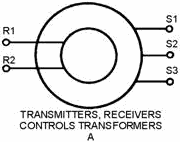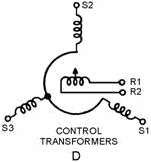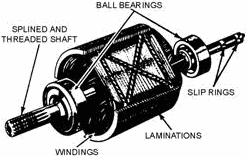NEETS Module 15 - Principles of Synchros, Servos, and Gyros
Pages i,
1-1,
1-11,
1-21,
1-31,
1-41,
1-51,
1-61,
1-71,
2-1,
2-11,
2-21,
2-31,
3-1,
3-11,
3-21,
4-1, Index
| - |
Matter, Energy,
and Direct Current |
| - |
Alternating Current and Transformers |
| - |
Circuit Protection, Control, and Measurement |
| - |
Electrical Conductors, Wiring Techniques,
and Schematic Reading |
| - |
Generators and Motors |
| - |
Electronic Emission, Tubes, and Power Supplies |
| - |
Solid-State Devices and Power Supplies |
| - |
Amplifiers |
| - |
Wave-Generation and Wave-Shaping Circuits |
| - |
Wave Propagation, Transmission Lines, and
Antennas |
| - |
Microwave Principles |
| - |
Modulation Principles |
| - |
Introduction to Number Systems and Logic Circuits |
| - |
- Introduction to Microelectronics |
| - |
Principles of Synchros, Servos, and Gyros |
| - |
Introduction to Test Equipment |
| - |
Radio-Frequency Communications Principles |
| - |
Radar Principles |
| - |
The Technician's Handbook, Master Glossary |
| - |
Test Methods and Practices |
| - |
Introduction to Digital Computers |
| - |
Magnetic Recording |
| - |
Introduction to Fiber Optics |
| Note: Navy Electricity and Electronics Training
Series (NEETS) content is U.S. Navy property in the public domain. |
Chapter 1
SYNCHROS
Learning Objectives
Learning objectives are stated at the beginning of each chapter. These learning
objectives serve as a preview of the information you are expected to learn in the
chapter. The comprehensive check questions placed throughout the chapters are based
on the objectives. By successfully completing the Nonresident Training Course (NRTC),
you indicate that you have met the objectives and have learned the information.
The learning objectives for this chapter are listed below.
Upon completing this chapter, you will be able to:
1. Define the term "synchro."
2. State the primary purpose of a synchro.
3. Explain the importance of synchros in naval equipment.
4. Name the two general classifications of synchros.
5. Explain the differences between torque and control synchros.
6. Name the seven functional classes of synchros and list all inputs
and outputs.
7. Name the two types of synchro identification codes.
8. Interpret all synchro markings and identify the particular codes used.
9. Draw the five standard schematic symbols for synchros and identify
all connections.
10. Describe the general construction and physical appearance of
synchro rotors and stators.
11. Name the two common types of synchro rotors, giving an application
of each.
12. List the different synchro characteristics and give a brief explanation
of each.
13. State the advantage of using 400-Hz synchros over 60-Hz synchros.
14. Explain the operation of a basic synchro transmitter and receiver.
15. State the difference between a synchro transmitter and a synchro
receiver.
16. List the basic components that compose a torque synchro system.
17. Explain the operation of a simple synchro transmission system.
18. Define the term "correspondence" and explain how it is used in
a simple synchro system.
19. Explain the principle behind reversing the S1 and S3 leads on
a synchro receiver and how this action affects receiver operation.
20. Explain what happens when the rotor leads on a synchro transmitter
or receiver are reversed.
21. State the purposes of differential synchros.
22. Name the two types of differential synchros and give a brief
explanation of each.
23. Explain the difference between the torque differential transmitter
and the torque differential receiver.
24. Name the components that make up the TDX and the TDR synchro
systems.
25. Explain how the two differential synchro systems add and subtract.
26. State the wiring changes required to convert the differential
synchro systems from subtraction to addition.
27. State the purposes and functions of control synchros.
28. Name the different types of control synchros.
29. Explain how the CX and CDX differ from the TX and TDX.
30. Explain the theory and operation of a control transformer.
31. List the basic components that compose a control synchro system.
32. Explain the operation of a control synchro system and how it
is used to control a servo system.
33. State the purpose and function of the synchro capacitor.
34. Explain how synchro capacitors improve the accuracy of synchro
systems.
35. Explain the method used to connect synchro capacitors in a circuit.
36. Define single and multispeed synchro systems.
37. State the purposes and functions of multispeed synchro systems.
38. Stale the purposes for zeroing synchros.
39. Name three common synchro zeroing methods and give a brief explanation
of each.
40. Explain the different troubleshooting techniques used in isolating
synchro malfunctions and breakdowns.
SYNCHRO FUNDAMENTALS
Synchros play a very important role in the operation of Navy equipment. Synchros
are found in just about every weapon system, communication system, underwater detection
system, and navigation system used in the Navy. The importance of synchros is sometimes
taken lightly because of their low failure rate. However, the technician who understands
the theory of operation and the alignment procedures for synchros is well ahead
of the problem when a malfunction does occur. The term "synchro" is an abbreviation
of the word "synchronous." It is the name given to a variety of rotary, electromechanical,
position-sensing devices. Figure 1-1 shows a phantom view of typical synchro. a
synchro resembles a
small electrical motor in size and appearance and operates like a variable transformer.
The synchro, like the transformer, uses the principle of electromagnetic induction.

Figure 1-1. - Phantom view of a synchro.
Synchros are used primarily for the rapid and accurate transmission of information
between equipment and stations. Examples of such information are changes in course,
speed, and range of targets or missiles; angular displacement (position) of the
ship's rudder; and changes in the speed and depth of torpedoes. This information
must be transmitted quickly and accurately. Synchros can provide this speed and
accuracy. They are reliable, adaptable, and compact. Figure 1-2 shows a simple synchro
system that can be used to transmit different as of data or information In this
system, a single synchro transmitter furnishes information to two synchro receivers
located in distant spaces. Operators put information into the system by turning
the handwheel. As the handwheel turns, its attached gear rotates the transmitter
shaft (which has a dial attached to indicate the value of the transmitted information).
As the synchro transmitter shaft turns, it converts the mechanical input into an
electrical signal, which is sent through interconnecting wiring to the two synchro
receivers. The receiver shafts rotate in response to the electrical signal from
the transmitter. When these shafts turn, the dials attached to the shafts indicate
the transmitted information.

Figure 1-2. - Data transfer with synchros.
By studying the simple synchro system, you can see that information can be transmitted
over long distances, from space to space, and from equipment to equipment.
In addition to supplying data by positioning dials and pointers, synchros are
also used as control devices in servo systems. When the synchro and the servo are
combined, they work as a team to move and position heavy loads. The methods used
to accomplish this are covered in detail in the next chapter.
Q-1. What is the name given to a variety of rotary electromechanical,
position sensing devices?
Q-2. What is the primary purpose of a synchro system?
SYNCHRO Classification
Synchros work in teams. Two or more synchros interconnected electrically form
a synchro system. There are two general classifications of synchro systems - TORQUE
Systems and CONTROL Systems. Torque-synchro systems use torque synchros and control-synchro
systems use control synchros. The load dictates the type of synchro system, and
thus the type of synchro.
Torque-synchro systems are classified "torque" because they are mainly concerned
with the torque or turning force required to move light loads such as dials, pointers,
or similar indicators. The positioning of these devices requires a relatively low
amount of torque. Control synchros are used in systems that are designed to move
heavy loads such as gun directors, radar antennas, and missile launchers.
In addition to the two general classifications, synchros are grouped into seven
basic functional classes as shown in table 1-1. Four of these are the torque type
and three are the control type. Each synchro is described in the table by name,
abbreviation, input, output, and the other synchro units that may be connected to
it. Generally, torque and control synchros may not be interchanged. The functional
operation of each of these seven synchros is covered later in this text.
Table 1-1. - Synchro Information

Synchros are also classified according to their operating frequency. This classification
was brought about by the development of the 400-Hz synchro. Prior to this time,
the 60-Hz synchro was the only one in use. Synchro operating frequencies are covered
in detail in the section on synchro characteristics.
Q-3. Name the two general classifications of synchro systems.
Q-4. What is the difference between a torque synchro and a control
synchro? Q-5. Using table 1-1, name two synchros that provide a mechanical
output.
STANDARD MARKINGS and SYMBOLS
Synchros used in the Navy can be grouped into two broad categories: MILITARY
STANDARD SYNCHROS and PRESTANDARD NAVY SYNCHROS. Military standard synchros conform
to specifications that are uniform throughout the armed services. New varieties
of equipment use synchros of this type. Prestandard synchros were designed to meet
Navy, rather than service-wide, specifications. Each category has its own designation
code for identification.
Military Standard Synchro Code
The military standard designation code identifies standard synchros by their
physical size, functional purpose, and supply voltage characteristics. The code
is alphanumerical and is broken down in the following manner. The first two digits
indicate the diameter of the synchro in tenths of an inch, to the next higher tenth.
For example, a synchro with a diameter of 1.75 inches has the numeral 18 as its
first two digits. The first letter indicates the general function of the synchro
and of the synchro system-C for control or T for torque. The next letter indicates
the specific function of the synchro, as follows:

If the letter B follows the specific function designation, the synchro has a
rotatable stator. The last number in the designation indicates the operating frequency-6
for 60 Hz and 4 for 400 Hz. The upper-case letter following the frequency indicator
is the modification designation. The letter "A" indicates that the synchro design
is original. The first modification is indicated by the letter "B." Succeeding modifications
are indicated by the letters "C," "D," and so on, except for the unused letters
"I," "L," "O," and "Q."
For example, an 18TR6A synchro is an original design, 60-Hz torque receiver with
a diameter of between 1.71 and 1.80 inches.
A synchro designated 16CTB4B is the first modification of a 400-Hz control transformer
with a rotatable stator and a diameter of between 1.51 and 1.60 inches.
All standard synchros are labeled with such a code. Synchros used in circuits
supplied by 26 volts are classified in the same way, except that the symbol 26V
is prefixed to the designator (for example, 26V-16CTB4A). Otherwise, a 115 volts
source is assumed for the synchro system.
Navy Prestandard Synchro Code
The Navy prestandard designation code identifies prestandard synchros by size
and function, using a number and letter combination. Unlike the standard code, the
number does not indicate directly the diameter of the synchro. The number merely
represents the approximate size of the synchro, increasing as the size increases.
The approximate size and weight of the five most common sizes are shown in the following
table.

Note that prestandard size 1 is approximately the same size as standard size
23 (2.21 to 2.30 inches in diameter). Prestandard size 3 is approximately the same
size as standard size 31. Prestandard size 5 is approximately the same size as standard
size 37.
The letters used in the prestandard coding system indicate the function, mounting,
or special characteristics of the synchro as shown in the following chart.

Navy prestandard synchros are rarely used today. They have been replaced by
the standard synchro. However, by being familiar with the prestandard coding system,
you will be able to identify the older synchros and make correct replacements if
necessary.
Q-6. What does the code 26V-11TX4D mean on a synchro nameplate?
Q-7. Which of the two synchro designation codes is indicated by 5DG
on a synchro nameplate?
Schematic Symbols
Schematic symbols for synchros are drawn by various manufacturers in many different
ways. Only five symbols (as shown in figure 1-3), however, meet the standard military
specifications for schematic diagrams of synchros and synchro connections. When
a symbol is used on a schematic, it will be accompanied by the military abbreviation
of one of the eight synchro functional classifications (TR, TX, TDX, etc.).
The symbols shown in views a and B of figure 1-3 are used when it is necessary
to show only the external connections to a synchro, while those shown in views C,
D, and E are used when it is important to see the positional relationship between
the rotor and stator. The letters R and S, in conjunction with an Arabic number,
are used to identify the rotor and stator connections; for example, R1, R2, S1,
S2, and S3. The small arrow on the rotor symbol indicates the angular displacement
of the rotor; in figure 1-3 the displacement is zero degrees.

Figure 1-3A. - Schematic symbols for synchros.

Figure 1-3B. - Schematic symbols for synchros.

Figure 1-3C. - Schematic symbols for synchros.

Figure 1-3D. - Schematic symbols for synchros.

Figure 1-3E. - Schematic symbols for synchros.
Q8. On the synchro schematic symbol, what indicates the angular displacement
of the rotor?
SYNCHRO CONSTRUCTION
Figure 1-4 shows a cutaway view of a typical synchro. Having the knowledge of
how a synchro is constructed should enable you to better understand how synchros
operate.

Figure 1-4. - Typical synchro assembly.
In this section we will discuss how rotors and stators are constructed and how
the synchro is assembled. Each synchro contains a rotor, similar in appearance to
the armature in a motor, and a stator, which corresponds to the field in a motor.
The synchro stator is composed of three Y-connected windings (S1, S2, and
S3). The rotor is composed of one single winding (R1 and R2). As you can see in
the figure, the rotor winding is free to turn inside the stator. The rotor is usually
the primary winding and receives its voltage (excitation) from an external voltage
source. The stator receives its voltage from the rotor by magnetic coupling.
ROTOR CONSTRUCTION
There are two common types of synchro rotors in use-the SALIENT-POLE ROTOR and
the DRUM or WOUND ROTOR. The salient-pole rotor shown in figure 1-5 has a single
coil wound on a laminated core. The core is shaped like a "dumb-bell" or the letter
"H."

Figure 1-5. - Salient-pole rotor.
|





















